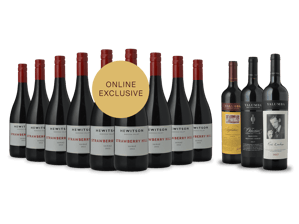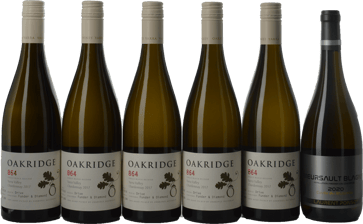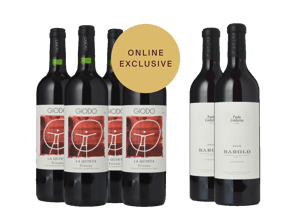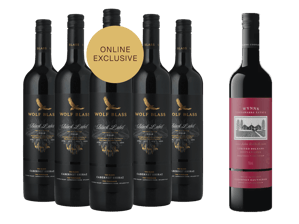- Home
- Wine Store
- PENFOLDS Bin 311 Chardonnay, Multi Region Blend 2019 Bottle
penfolds
PENFOLDS Bin 311 Chardonnay, Multi Region Blend 2019 Bottle
penfolds
PENFOLDS Bin 311 Chardonnay, Multi Region Blend 2019 Bottle
About this wine
Penfolds Bin 311 Chardonnay, Multi Region Blend
Bin 311 is considered one of the very finest, best-value cool-climate Chardonnays in Australia. In the context of Penfolds’ Chardonnay, Bin 311 is to Yattarna as Bin 389 is to Grange. The wine is made from declassified parcels of A1-graded Chardonnay grapes that would otherwise go into Yattarna and matured in the same French oak barrels that previously held Yattarna.
Wine Details
Classification and Scores
Taste Profile
Winery and Region
Delivery and Returns
All wine bought and sold through LANGTONS is held securely in our state-of-the-art, temperature-controlled National Warehouse, just outside of Melbourne, ensuring fast and efficient shipping to your nominated address Australia-wide.
Shipping Charges Within Australia
All orders placed are subject to a flat shipping fee as outlined below:
| Metro Areas | Regional Areas |
| $18.50 | $23 |
Find our more about our Delivery Options and Returns and Refunds Policy
Expert Review
Andrew Caillard MW
Pale gold. Fresh grapefruit white apricot aromas with tonic water/ flinty complexity. Supple fruit sweet palate with intense grapefruit, peach, bitter lemon flavours, creamy textures, some al-dente notes and long fresh linear acidity. Finishes crisp with plentiful apricot, peach notes.
93 points (2020)
Expert Review
Tyson Stelzer
Letting Penfolds chardonnay wizard Kym Schroeter off his leash with Bin 311 sourcing (until a few years back it was almost always purely Tumbarumba) has elevated this cuvée to effectively become a baby Yattarna in both recipe and aspiration (and I wrote this before I read Peter Gago’s suggestion of the same) – an astute move in the grand hierarchy of Penfolds classification and declassification (it did, after all, set the precedent for multi-regional blending in South Australian red wines). The result in 2019 is nothing short of stunning; an intricate and eloquent weaving together of the tension of white citrus, the understated generosity of white peach and fig, the complexity of understated, classy cashew nut French oak and Schroeter’s signature struck flint reduction. If you adore Yattarna and Bin A (as I do), this is your everyday substitute – cut from the same mould, just toned down in concentration, tension, texture, complexity, persistence and endurance – and in this day and age, that’s not altogether a bad thing. It pips the great 2014 as the best Bin 311 yet.
95 points (July 2020)
Expert Review
Huon Hooke
Bright, light-yellow colour, with a very appealing spicy aroma which incorporates substantial nutty spicy oak. The wine is full in the mouth and rich, weighty and hearty with quite a strong tannin grip firming up the back-palate and finish. It's slightly bitter: a little chewy for me.
90 points, The Real Review (July 2020)
Expert Review
Matthew Jukes
Peter Gago mused that this wine was gradually heading towards being talked about as a kind of ‘Baby- Yattarna’. It is a nice sound bite, and it certainly looks to the same three wine regions for its source material, but the shape and size of Bin 311 is nothing like Yattarna and so it will be interesting to watch this wine’s style evolve, or perhaps not, over coming years. With fewer months spent in a slightly higher percentage of new oak than last year’s wine, this is a tighter and more linear Bin 311 than I could have imagined. There is a chalky, savoury note on the finish of this wine which makes it rather challenging and this needs to dissolve before opening a bottle in anger. I have a feeling that Bin 311 could do with relaxing a little and not harking back to its 100% Tumbarumba heritage because this is a square peg in a round hole and I feel its edges need to be routed smooth. While Penfolds doesn’t want any discernible opulence in this wine, because Bin A and Yattarna have more than enough to go around, there is still an intentional angularity here which look natural in the wines of yore, but which look raw and unfinished in this vintage. There is no doubt that this anomaly might soften with time, but I wouldn’t bet on it. Having said this, I am always in search of perfection, hence my comments, and this wine has masses of epic fruit and a dreamy perfume, so don’t let me put you off if you can accommodate the unfinished seams in this creation.
18 points (July 2020)
Expert Review
Campbell Mattinson
Yes it’s lovely. Straw-coloured, as fleshy as its is flinty, awash with white peach and citrus. It’s taut to close but it feels as if it’s itching to push longer. It saw 35% new oak and its presence is clear but the quality of the fruit is up to it and then some. Spice, toast, a whisper of custard powder and a softness to the texture. But there’s a sureness to the acid line and that finish, it’ll fly when its time comes. I really like this. I’d be surprised if I didn’t score it higher in time.
93+ points, The Wine Front (July 2020)
Expert Review
Jancis Robinson MW
Really quite rich and leesy on the nose. Clean, crisp, youthful fruit and, at present, a little hard and ungenerous on the finish. Just slightly pinched. Though after that the flavour goes on and on on the palate. Well made. Just not especially distinctive.
16+ points, JancisRobinson.com (June 2020)
Expert Review
Ray Jordan
In keeping with the Penfolds approach to this wine, this is a blend of three regions - Tasmania, Adelaide Hills and Tumbarumba. It's immediately engaging with a creamy stone fruit and citrus aromatic merging into cashew and a slight waxy character. The palate is refined and restrained with a juicy mouth feel displaying flavours of grapefruit. Excellent wine.
93 points, The West Australian (July 2020)
Expert Review
Nick Stock
This is a blend of three regions, Tasmania, Tumbarumba and Adelaide Hills. It’s Tasmania that really powers this wine in 2019. Opens on a chalky and stony edge with intense, vibrant white-peach and citrus aromas. The palate has a resolved, complete and smooth-honed texture. Flavors of ripe peaches, honey and citrus sit amid fresh, crisp acidity and a long, attractively pithy grapefruit and peach finish. Drink over the next five years.
94 points, JamesSuckling.com (July 2020)
Expert Review
Decanter
Deceptively delicate, even though it has been framed within a quite sturdy oak outline. The body of the wine is quite fragile – a fine porcelain vase. A whiff of toasty oak rides ahead of very gentle peach blossom. The sliver of lemon has surprising persistence, revealing some pleasing roasted cashew and mineral bite before a squeeze of tart grapefruit providing pucker at the finish. It’s all very prim and elegant, straight-backed and on its best behaviour, but one wonders whether it can loosen up with age.
90 points, David Sly, Decanter (July 2020)
Expert Review
Joe Czerwinski
Sourced from Tasmania, Adelaide Hills and Tumbarumba, Penfolds is seeking to position the 2019 Bin 311 Chardonnay as something of a "Junior Yattarna." I guess that's one way to characterize the stuff that doesn't make the cut for the flagship Chardonnay. In truth, this is a fine wine in its own right, boasting struck-match complexity on the nose alongside hints of apple, white peach and lime. Barrel fermented and matured in 35% new French oak, it's medium-bodied and silky textured, but it hides the oak well, ending in a lingering wash of citrus.
91 points, Wine Advocate (July 2020)
Expert Review
Ned Goodwin MW
"Serious Chardonnay here. A meld of cool climate Tasmania, Tumbarumba and Adelaide Hills fruit. The confluence of oak, notes of nougatine and creamed cashew at the core and a pungent mineral freshness, impeccable. Stone fruit allusions, all. Glossy and full across the mid-palate, with a burst of freshness towing it long."
93 points (July 2020)
Penfolds
Penfolds is one of the world’s most celebrated winemakers with an enviable reputation for quality at every price level. Christopher Rawson Penfold began it all in 1844. A doctor, with an eye for medicinal winemaking, he and his wife, Mary sought a new life in Australia with a vine cutting and a bold vision. The family purchased Magill, now a suburb of Adelaide, and set about inventing tonics, brandies, and fortified wines made from grapes and Australian sunshine. The Penfolds House Style emerged from this craft of fortified wine production and blending.
The success of Penfolds has been driven by a lineage of visionary winemakers who pushed innovation to bold new heights. Max Schubert, the creator of Penfolds Grange, Dr Ray Beckwith and their team pioneered: major advances in yeast technology and paper chromatography; the understanding and use of pH in controlling bacterial spoilage; the use of headed down/submerged cap fermentation and the technique of rack and return; cold fermentation practices; the use of American oak as a maturation vessel and perhaps most critically, partial barrel fermentation. The use of American oak and barrel fermentation is considered traditional Barossa winemaking practice, in large part due to the work of Penfolds.
Today, the art of blending remains integral to the Penfolds House Style - a unique combination of highly defined fruit aromas, ripe tannins, richness, power and concentration. The most powerful expression of this is the flagship, Grange, now recognised as one of the most consistent of the world’s great wines. Similarly, Bin 389 Cabernet Shiraz, first released in 1960, is now considered the quintessential Australian wine blend. Improved vineyard management, site selection and winemaking brought about the subsequent releases of Penfolds wines such as Bin 707 and Bin 407 Cabernet Sauvignon – both highly acclaimed and collected wines to this day.
The Penfolds Philosophy is the accumulation of nearly 180 years of shared knowledge and continual refinement. This began with Dr Christopher and Mary Penfold, continued with Max Schubert, Ray Beckwith and generations of Penfolds winemakers leading to the current winemaking team, led by Peter Gago. Their commitment to constantly improving their work, whilst honouring the winemaking techniques of their predecessors, contributes to the consistency of style and quality that Penfolds is known for around the world.







